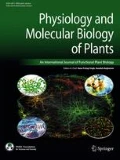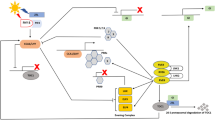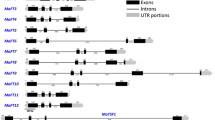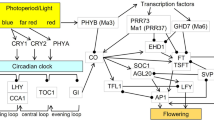Abstract
Mango, an important fruit crop of the tropical and subtropical regions shows alternate bearing in most varieties causing a financial loss to the farmer. Genetic reasons for this undesirable trait have not been studied so far. In our attempts to investigate the genetic reasons for alternate bearing we have initiated studies on genes associated with the induction, repression and regulation of flowering in mango. We have previously identified and characterized FLOWERING LOCUS T (FT) genes that induce flowering and two TERMINAL FLOWER1 (TFL1) genes that repress flowering. In this communication, we have explored the association of GI-FKF1-CDF1-CO module with the regulation of flowering in mango. The role of this module in regulating flowering has been well documented in photoperiod sensitive plants. We have characterized these genes and their expressions during flowering in Ratna variety as also their diurnal fluctuations and tissue specific expressions. The data taken together suggest that GI-FKF1-CDF1-CO module may also be employed by mango in regulating its flowering. Further, we suggest that the temperature dependent flowering in mango is probably associated with the presence of temperature sensitive elements present in the promoter region of one of the GIGANTEA genes that have been shown to be closely associated with floral induction.


taken from mango genome published by Wang et al 2020), Arabidopsis (AtGI) and citrus (CsGI) showing the nuclear localization region containing four clusters of basic amino groups shown in red colored letters (and black line at top) and red/black color triangle indicating junction between amino acid 749 to 750 whose disruption disturbs the function of GI. Red line box indicates the presence of two additional amino acids in MiGI2 accounting for the difference of two amino acids between the two genes. The full sequence of GIs is given in Supplementary Fig. 2. B Boxshade alignment of deduced amino acid sequences of CONSTANS LIKE (CO) protein family including mango (MiCO1 and MiCO2), mango SiJiMi (MiCO S), TaiNong No. 1 (MiCO T), citrus (CsCOL4) and Arabidopsis (AtCO1, AtCOL1). B-box1, B-box2 and CCT domain are indicated in the figure.





Similar content being viewed by others
References
Abe M, Kobayashi Y, Yamamoto S et al (2005) FD, a bZIP protein mediating signals from the floral pathway integrator FT at the shoot apex. Science 80–309:1052–1056. https://doi.org/10.1126/science.1115983
Andrés F, Coupland G (2012) The genetic basis of flowering responses to seasonal cues. Nat Rev Genet 13:627–639. https://doi.org/10.1038/nrg3291
Barros PM, Cherian S, Costa M et al (2017) The identification of almond GIGANTEA gene and its expression under cold stress, variable photoperiod, and seasonal dormancy. Biol Plant 61:631–640. https://doi.org/10.1007/s10535-017-0711-1
Bowman JL, Alvarez J, Weigel D et al (1993) Control of flower development in Arabidopsis thaliana by APETALA 1 and interacting genes. Development 119:721–743
Brandoli C, Petri C, Egea-Cortines M, Weiss J (2020) Gigantea: uncovering new functions in flower development. Genes (basel) 11:1–15. https://doi.org/10.3390/genes11101142
Campanella JJ, Bitincka L, Smalley J (2003) MatGAT: an application that generates similarity/identity matrices using protein or DNA sequences. BMC Bioinformatics 4:1–4. https://doi.org/10.1186/1471-2105-4-29
Davenport TL (2007) Reproductive physiology of mango. Brazilian J Plant Physiol 19:363–376. https://doi.org/10.1590/S1677-04202007000400007
Dellaporta SL, Wood J, Hicks JB (1983) A plant DNA minipreparation: version II. Plant Mol Biol Report 1:19–21. https://doi.org/10.1007/BF02712670
Alison MD, White AJ, Vural S, Hughes MA (1998) Identification of promoter elements in a low-temperature-responsive gene (blt4.9) from barley (Hordeum vulgare L.). Plant Mol Biol 38:551–564. https://doi.org/10.1023/A:1006098132352
Fan ZY, He XH, Fan Y et al (2020) Isolation and functional characterization of three MiFTs genes from mango. Plant Physiol Biochem 155:169–176. https://doi.org/10.1016/j.plaphy.2020.07.009
Fernández V, Takahashi Y, Le Gourrierec J, Coupland G (2016) Photoperiodic and thermosensory pathways interact through CONSTANS to promote flowering at high temperature under short days. Plant J 86:426–440. https://doi.org/10.1111/tpj.13183
Fornara F, Panigrahi KCS, Gissot L et al (2009) Arabidopsis DOF transcription factors act redundantly to reduce CONSTANS expression and are essential for a photoperiodic flowering response. Dev Cell 17:75–86. https://doi.org/10.1016/j.devcel.2009.06.015
Fowler S, Lee K, Onouchi H et al (1999) GIGANTEA: a circadian clock-controlled gene that regulates photoperiodic flowering in Arabidopsis and encodes a protein with several possible membrane-spanning domains. EMBO J 18:4679–4688. https://doi.org/10.1093/emboj/18.17.4679
Gocal GF, King RW, Blundell CA et al (2001) Evolution of floral meristem identity genes. Analysis of Lolium temulentum genes related to APETALA1 and LEAFY of Arabidopsis. Plant Physiol 125:1788–1801. https://doi.org/10.1104/pp.125.4.1788
Hong SY, Lee S, Seo PJ et al (2010) Identification and molecular characterization of a Brachypodium distachyon GIGANTEA gene: Functional conservation in monocot and dicot plants. Plant Mol Biol 72:485–497. https://doi.org/10.1007/s11103-009-9586-7
Hu B, Jin J, Guo AY et al (2015) GSDS 2.0: an upgraded gene feature visualization server. Bioinformatics 31:1296–1297. https://doi.org/10.1093/bioinformatics/btu817
Huang F, Fu Z, Zeng L, Morley-Bunker M (2017) Isolation and characterization of GI and FKF1 homologous genes in the subtropical fruit tree Dimocarpus longan. Mol Breed 37:1–13. https://doi.org/10.1007/s11032-017-0691-z
Huq E, Tepperman JM, Quail PH et al (2000) GIGANTEA is a nuclear protein involved in phytochrome signaling in Arabidopsis. Proc Natl Acad Sci 97:9789–9794. https://doi.org/10.1073/PNAS.170283997
Jakoby M, Weisshaar B, Dröge-Laser W et al (2002) bZIP transcription factors in Arabidopsis. Trends Plant Sci 7:106–111. https://doi.org/10.1016/S1360-1385(01)02223-3
Ke Q, Kim HS, Wang Z et al (2017) Down-regulation of GIGANTEA-like genes increases plant growth and salt stress tolerance in poplar. Plant Biotechnol J 15:331–343. https://doi.org/10.1111/pbi.12628
Kinmonth-Schultz Hannah A. 1, Xinran Tong1, Jae Lee1, Young Hun Song1, 2 SI, Soo-Hyung Kim3 and TI (2016) Cool nighttime temperatures induce the expression of CONSTANS and FLOWERING LOCUS T to regulate flowering in Arabidopsis. New Phytol. 211:208–224. https://doi.org/10.1111/nph.13883
Krishna B, Vyavahare SN, Chaudhari RS et al (2017) Roles of flowering locus T (FT) and terminal flower 1 (TFL1) in flowering of mango. Acta Hortic 1183:125–131. https://doi.org/10.17660/ActaHortic.2017.1183.17
Liu L, Liu C, Hou X et al (2012) FTIP1 is an essential regulator required for florigen transport. PLoS Biol. https://doi.org/10.1371/journal.pbio.1001313
Liu Y, Luo C, Zhang XJ et al (2020) Overexpression of the mango MiCO gene delayed flowering time in transgenic Arabidopsis. Plant Cell Tissue Organ Cult. https://doi.org/10.1007/s11240-020-01894-3
Livak KJ, Schmittgen TD (2001) Analysis of relative gene expression data using real-time quantitative PCR and the 2-ΔΔCT method. Methods 25:402–408. https://doi.org/10.1006/meth.2001.1262
Mishra P, Panigrahi KC (2015) GIGANTEA - an emerging story. Front Plant Sci 6:1–15. https://doi.org/10.3389/fpls.2015.00008
Moon J, Lee H, Kim M, Lee I (2005) Analysis of flowering pathway integrators in Arabidopsis. Plant Cell Physiol 46:292–299. https://doi.org/10.1093/pcp/pci024
Morris K, Jackson SD (2010) DAY NEUTRAL FLOWERING does not act through GIGANTEA and FKF1 to regulate CONSTANS expression and flowering time. Plant Signal Behav 5:1105–1107. https://doi.org/10.4161/psb.5.9.12416
Morris K, Thomber S, Codrai L et al (2010) DAY NEUTRAL FLOWERING represses CONSTANS to prevent arabidopsis flowering early in short days. Plant Cell 22:1118–1128. https://doi.org/10.1105/tpc.109.066605
Nakagawa M, Honsho C, Kanzaki S et al (2012) Isolation and expression analysis of FLOWERING LOCUS T-like and gibberellin metabolism genes in biennial-bearing mango trees. Sci Hortic (amsterdam) 139:108–117. https://doi.org/10.1016/j.scienta.2012.03.005
Nelson DC, Lasswell J, Rogg LE et al (2000) FKF1, a clock-controlled gene that regulates the transition to flowering in Arabidopsis. Cell 101:331–340. https://doi.org/10.1016/S0092-8674(00)80842-9
Núñez-Elisea R, Davenport TL (1994) Flowering of mango trees in containers as influenced by seasonal temperature and water stress. Sci Hortic (amsterdam) 58:57–66. https://doi.org/10.1016/0304-4238(94)90127-9
Park DH, Somers DE, Kim YS et al (1999) Control of circadian rhythms and photoperiodic flowering by the Arabidopsis GIGANTEA gene. Science 285:1579–1582. https://doi.org/10.1126/science.285.5433.1579
Rajatiya J (2018) Climate change: impact, mitigation and adaptation in fruit crops. Int J Pure Appl Biosci 6:1161–1169. https://doi.org/10.18782/2320-7051.6161
Robson F, Costa MMR, Hepworth SR et al (2001) Functional importance of conserved domains in the flowering-time gene CONSTANS demonstrated by analysis of mutant alleles and transgenic plants. Plant J 28:619–631. https://doi.org/10.1046/j.1365-313x.2001.01163.x
Sawa M, Kay SA (2011) GIGANTEA directly activates flowering locus T in Arabidopsis thaliana. Proc Natl Acad Sci U S A 108:11698–11703. https://doi.org/10.1073/pnas.1106771108
Sawa M, Nusinow DA, Kay SA, Imaizumi T (2007) FKF1 and GIGANTEA complex formation is required for day-length measurement in Arabidopsis. Science 318:261–265. https://doi.org/10.1126/science.1146994
Sharma N, Singh AK, Singh SK et al (2020) Comparative RNA sequencing based transcriptome profiling of regular bearing and alternate bearing mango (Mangifera indica L.) varieties reveals novel insights into the regulatory mechanisms underlying alternate bearing. Biotechnol Lett 42:1035–1050. https://doi.org/10.1007/s10529-020-02863-8
Song YH, Estrada DA, Johnson RS et al (2014) Distinct roles of FKF1, GIGANTEA, and ZEITLUPE proteins in the regulation of CONSTANS stability in Arabidopsis photoperiodic flowering. Proc Natl Acad Sci U S A 111:17672–17677. https://doi.org/10.1073/pnas.1415375111
Song YH, Smith RW, To BJ et al (2012) FKF1 conveys timing information for CONSTANS stabilization in photoperiodic flowering. Science 336:1045–1049. https://doi.org/10.1126/science.1219644
Suárez-López P, Wheatley K, Robson F et al (2001) CONSTANS mediates between the circadian clock and the control of flowering in Arabidopsis. Nature 410:1116–1120. https://doi.org/10.1038/35074138
Sukhvibul N, Hetherington SE, Whiley AW, Smith MK, Vithanage V (2000) Effect of temperature on Inflorescence development and floral biology of mango (Mangifera indica L.). Acta Hortic 509:601–607
Taylor A, Massiah AJ, Thomas B (2010) Conservation of Arabidopsis thaliana photoperiodic flowering time genes in onion (Allium cepa L.). Plant Cell Physiol 51:1638–1647. https://doi.org/10.1093/pcp/pcq120
Valverde F, Mouradov A, Soppe W et al (2004) Photoreceptor regulation of constans protein in photoperiodic flowering. Science 303:1003–1006. https://doi.org/10.1126/science.1091761
Vyavahare SN, Krishna B, Joshi SS, Chaudhari RS et al (2017) Characterization of mango flowering locus T (FT) and treminal flower 1 (TFL1) genes. Acta Hortic 1:125–132. https://doi.org/10.17660/ActaHortic.2017.1183.17
Wang P, Luo Y, Huang J et al (2020) The genome evolution and domestication of tropical fruit mango. Genome Biol 21:1–17. https://doi.org/10.1186/s13059-020-01959-8
Wei J, Liu D, Liu G et al (2016) molecular cloning, characterization, and expression of MiSOC1: a homolog of the flowering gene suppressor of overexpression of CONSTANS1 from mango (Mangifera indica L.). Front Plant Sci 7:1–13. https://doi.org/10.3389/fpls.2016.01758
Weigel D, Alvarez J, Smyth DR et al (1992) LEAFY controls floral meristem identity in Arabidopsis. Cell 69:843–859. https://doi.org/10.1016/0092-8674(92)90295-N
Wickland DP, Hanzawa Y (2015) The FLOWERING LOCUS T/TERMINAL FLOWER 1 gene family: functional evolution and molecular mechanisms. Mol Plant 8:983–997. https://doi.org/10.1016/j.molp.2015.01.007
Wigge PA, Kim MC, Jaeger KE et al (2005) Integration of spatial and temporal information during floral induction in Arabidopsis. Science 309:1056–1059. https://doi.org/10.1126/science.1114358
Xiao G, Li B, Chen H et al (2018) Overexpression of PvCO1, a bamboo CONSTANS-LIKE gene, delays flowering by reducing expression of the FT gene in transgenic Arabidopsis. BMC Plant Biol 18:1–16. https://doi.org/10.1186/s12870-018-1469-0
Yadav A, Jayaswal PK, Venkat Raman K et al (2019) Transcriptome analysis of flowering genes in mango (Mangifera indica L.) in relation to floral malformation. J Plant Biochem Biotechnol 29:193–212. https://doi.org/10.1007/s13562-019-00541-z
Yu H, Luo C, Fan Y et al (2020) Isolation and characterization of two APETALA1-Like genes from mango (Mangifera indica L.). Sci Hortic (Amsterdam). https://doi.org/10.1016/j.scienta.2019.108814
Zeevaart JA (2008) Leaf-produced floral signals. Curr Opin Plant Biol 11:541–547. https://doi.org/10.1016/j.pbi.2008.06.009
Zerr DM, Hall JC, Rosbash M, Siwicki KK (1990) Circadian fluctuations of period protein immunoreactivity in the CNS and the visual system of drosophila. J Neurosci 10:2749–2762. https://doi.org/10.1523/jneurosci.10-08-02749.1990
Zhang L, Jiang Y, Zhu Y et al (2019) Functional characterization of GI and CO homologs from Eriobotrya deflexa Nakai forma koshunensis. Plant Cell Rep 38:533–543. https://doi.org/10.1007/s00299-019-02384-3
Zhang X, An L, Nguyen TH et al (2015) The cloning and functional characterization of peach CONSTANS and FLOWERING LOCUS T homologous genes PpCO and PpFT. PLoS ONE 10:1–16. https://doi.org/10.1371/journal.pone.0124108
Zhu J, Deng S, Lu P et al (2016) The Ccl1-Kin28 kinase complex regulates autophagy under nitrogen starvation. J Cell Sci 129:135–144. https://doi.org/10.1242/jcs.177071
Zoltowski BD, Imaizumi T (2014) Structure and function of the ZTL/FKF1/LKP2 group proteins in arabidopsis, 1st edn. Elsevier Inc, pp 213–239
Acknowledgements
We are deeply thankful to late Dr. B. H. Jain, founder architect of Jain Irrigation Systems (JISL) for motivation and encouragement to initiate this project and to provide all necessary facilities. We are also thankful to the chairman and management of JISL for all financial support. Authors are also thankful to Dr Abdul Azeez for his valuable guidance during the initial study on MiGI1.
Funding
Research was funded by internal sources of Jain Irrigation Systems Ltd.
Author information
Authors and Affiliations
Contributions
PVS and BK conceived and designed the research. SIP and SNV conducted the experiments and performed bioinformatics analysis. SIP, SNV, BK and PVS wrote the manuscript. All authors read and approved the manuscript.
Corresponding author
Ethics declarations
Conflicts of interest/Competing interest
Authors have no conflict of interest.
Additional information
Publisher's Note
Springer Nature remains neutral with regard to jurisdictional claims in published maps and institutional affiliations.
Supplementary Information
Below is the link to the electronic supplementary material.
Rights and permissions
About this article
Cite this article
Patil, S.I., Vyavahare, S.N., Krishna, B. et al. Studies on the expression patterns of the circadian rhythm regulated genes in mango. Physiol Mol Biol Plants 27, 2009–2025 (2021). https://doi.org/10.1007/s12298-021-01053-8
Received:
Revised:
Accepted:
Published:
Issue Date:
DOI: https://doi.org/10.1007/s12298-021-01053-8




